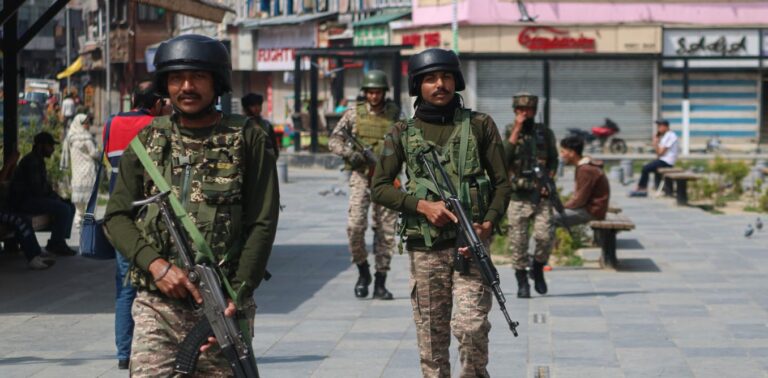Indian airstrikes deep into Pakistan and vindictive shelling throughout the border have actually put the subcontinent on edge when again, with lots of fearing an additional escalation in between the 2 nuclear next-door neighbors. A minimum of 26 individuals were eliminated on May 6, 2025, by rockets released by India, according to Pakistani authorities. India states it targeted “terrorist facilities” websites in the operation in action to an attack on April 22 that saw lots of travelers in Indian-administered Kashmir eliminated by shooters. Pakistan cautioned it would react “at a time, location and way of its picking.” Shelling by Pakistan throughout the “line of control” separating the Indian- and Pakistani-controlled parts of Kashmir eliminated 15 individuals, India states. It represents the most major combating in between the 2 nations in years. Kashmir has actually long been a source of stress in between India and Pakistan, as posts from The Conversation’s archive describe. 1. The roots of the dispute The disagreement over Kashmir, which rests on the northern idea of the Indian subcontinent and borders Pakistan to the west, can be traced back to the partition of India in 1947 and the policies of colonial British guideline that preceded it. As Sumit Ganguly, a specialist of Indian politics and diplomacy, discusses, the British offered the rulers of nominally self-governing handsome states the option of which nation they wished to sign up with post-partition: Muslim-majority Pakistan or Hindu-majority India. This put Maharaja Hari Singh, the queen of Jammu and Kashmir, in a challenging position– he was a Hindu judgment over a mainly Muslim population. “India, which was developed as a nonreligious state, wished to integrate Kashmir to show that a primarily Muslim area might flourish in a Hindu-majority nation devoted to secularism. Pakistan, on the other hand, looked for Kashmir since of its physical distance and Muslim bulk,” composes Ganguly. While Singh was still pondering, a disobedience broke out in Kashmir, with freshly independent Pakistan providing the insurgents support. India sent out soldiers in on condition that Singh officially accede to India, and the very first of 4 Indian-Pakistan wars started in 1947. It ended with Pakistan acquiring control of a 3rd of the challenged area. “Neither nation has actually completely reconciled itself to Kashmir’s status. India declares the state in its totality, as it ended up being a part of its area lawfully. Pakistan, nevertheless, has actually traditionally held the view that Kashmir was delivered to India by a ruler who did not represent its bulk Muslim population. This disagreement in between 2 nuclear-armed powers stays a prospective international flashpoint,” Ganguly includes. Find out more: 75 years earlier, Britain’s prepare for Pakistani and Indian self-reliance left unsolved disputes on both sides– specifically when it concerns Kashmir 2. More than a border disagreement But to see Kashmir exclusively through the lens of Indian-Pakistani competition would do the complex dispute an injustice. Typically overlooked in this reading is the views of lots of Kashmiris themselves, much of whom would choose self-reliance. Chitralekha Zutshi, a teacher of history at William & Mary, keeps in mind that the desire for autonomy by groups in the area has actually led to various self-reliance motions and duplicated uprisings. Fighters from the pro-independence Jammu and Kashmir Liberation Front parade in 1991. Mushtaq Ali/AFP by means of Getty Images Pakistan has actually supported a few of these motions, a truth that India has actually taken upon to “cross out discontent in the Kashmir Valley as a by-product of its territorial conflict with Pakistan,” Zutshi composes. In so doing, the complaints of “a whole generation of young Kashmiris” who see India as “an inhabiting power” have actually been overlooked, the scholar continues. She concludes: “The Kashmir conflict can not be solved bilaterally by India and Pakistan alone– even if the 2 nations wanted to interact to solve their distinctions. This is due to the fact that the dispute has numerous sides.” Learn more: Kashmir dispute is not simply a border disagreement in between India and Pakistan 3. A water war? Supporting the claim that the views of Kashmiris are typically overlooked is the reality that the Indus Waters Treaty– an important decades-old contract that permits Pakistan and India to share water utilize from the area’s rivers– was prepared mostly without the input of Kashmiri individuals, composes Fazlul Haq, a research study researcher at Ohio State University. Haq, who assists run the university’s Indus Basin Water Project, discusses that even before the current flare-up of violence, a conflict over the treaty was triggering stress in between India and Pakistan. The issue was that the initial treaty, hailed as a success for several years, didn’t consider the effect of environment modification. Melting glaciers have actually put the long-lasting sustainability of the treaty at threat, threatening the water system for more than 300 million individuals. Fazlul Haq/Bryan Mark/Byrd Polar and Climate Research Center/Ohio State University, CC BY “Despite being the main source of water for the basin, Kashmiris have actually had no function in settlements or decision-making under the treaty,” Haq composes. Nor did it offer a system for any local disagreements. “Tensions over hydropower tasks in Kashmir were bringing India and Pakistan towards diplomatic deadlock long before the current attack,” Haq notes. “The treaty now exists in a state of limbo. While it technically stays in force, India’s official notification for evaluation has actually presented unpredictability, stopping crucial cooperative systems and calling into question the treaty’s long-lasting toughness,” Haq composes. Pakistan has actually stated any effort to interrupt its water system under the treaty would be thought about “an act of war” Find out more: Tensions over Kashmir and a warming world have actually positioned the Indus Waters Treaty on life assistance 4. On the precipice of a brand-new war? There have actually been 4 full-blown disputes in between India and Pakistan: in 1947, 1965, 1971 and 1999. Because the turn of the centuries, cross-border skirmishes in Kashmir have actually mainly been included, in part due to external pressure from the United States and others who fear the financial and local effects of a dispute in between the nuclear-armed next-door neighbors. International relations professional Ian Hall, of Griffith University in Australia, composes that the calculus has actually altered a little. He keeps in mind that there is little financial expense to escalation, with “virtually no trade in between India and Pakistan.” The primary issue for both sides now is “the political expense they would experience not taking military action,” Hall includes. Find out more: India and Pakistan have actually combated lots of wars in the past. Are we on the precipice of a brand-new one? 5. The requirement for a Pakistan-India hotline During previous crises in between Pakistan and India, Washington has actually played an essential function in deescalating stress. U.S. President Donald Trump’s current remarks that he thinks Pakistan and India will “figure it out one method or the other” recommends this is one celebration in which the U.S. might take a rear seats. As Syed Ali Zia Jaffery at the University of Lahore and Nicholas John Wheeler at the University of Birmingham in the U.K. note, that produces an issue. “The lack of a relied on personal line of interaction in between the leaders of India and Pakistan is a significant barrier to compassionate interaction. It avoids the 2 reaching an appropriate gratitude of shared vulnerabilities that is so crucial to crisis de-escalation,” they compose. Their post utilizes the example of the Cuban rocket crisis of 1962 to promote the value of what the 2 scholars refer to as “compassionate channels of interaction.” U.S. President John F. Kennedy and his Soviet equivalent, Nikita Khrushchev, “exchanged a series of letters in which they acknowledged and revealed their shared vulnerability to nuclear war,” Jaffery and Wheeler compose. Developing shared compassion and a bond of trust were important to the serene resolution of the crisis. “Such a hotline in between the greatest levels of Indian and Pakistani diplomacy would be an essential action towards avoiding these crises from drawing out of control. More most importantly, it might play a critical function in handling crises when they do happen, using a crucial channel for peace of mind and de-escalation,” Jaffery and Wheeler include. Learn more: Why a hotline is required to assist bring India and Pakistan back from the verge of a devastating war.
Read More
India-Pakistan strikes: 5 important continues reading years of competition and stress over Kashmir






















0 Comments